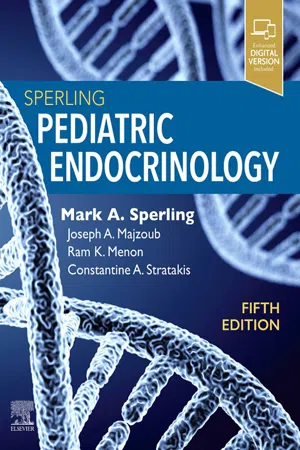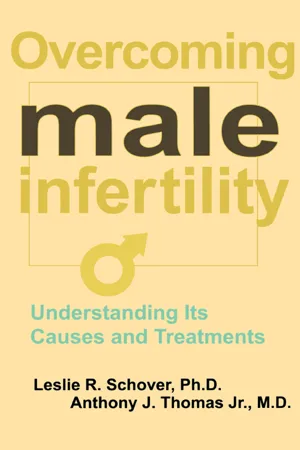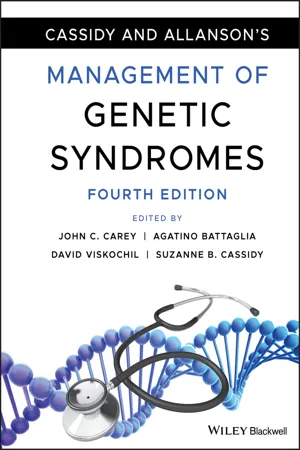Psychology
Klinefelter and Turner Syndrome
Klinefelter syndrome is a genetic condition in males characterized by the presence of an extra X chromosome, leading to physical and developmental differences. Turner syndrome, on the other hand, is a genetic condition in females caused by the complete or partial absence of one of the X chromosomes, resulting in short stature and other physical features. Both syndromes can impact psychological well-being and may require specialized support.
Written by Perlego with AI-assistance
Related key terms
Related key terms
1 of 4
Related key terms
1 of 3
10 Key excerpts on "Klinefelter and Turner Syndrome"
- eBook - ePub
- Judith E. Owen Blakemore, Sheri A. Berenbaum, Lynn S. Liben(Authors)
- 2013(Publication Date)
- Psychology Press(Publisher)
chapter 6 ) consider the effects of a missing or abnormal X chromosome, of reduced ovarian hormones early in development, and of increasing estrogens with treatment at puberty.Klinefelter Syndrome
Klinefelter syndrome (KS) results from an extra X chromosome in a karyotypic male, so the karyotype is 47,XXY (for reviews and additional information see Bojesen & Gravholt, 2007 ; Grumbach et al., 2003 ). It is the most common chromosomal disorder in males, occurring in approximately 1 in 500–1,000 male live births. Males with KS have decreased testicular volume, low sperm count, low testosterone, and other signs ofundervirilization, or reduced physical masculinization). They are tall and have long limbs. An interesting question is whether there is also reduced psychological masculinization, an issue to be explored in chapter 6 .46,Xxdsd
This category of DSDs concerns individuals who are born with a normal karyotype, including two X chromosomes, but whose physical appearance is masculinized (virilized) in some respects. These conditions can arise in several ways. In some cases, the fetus itself produces masculinizing hormones, usually because of a genetic disorder. In other cases, the fetus is exposed to masculinizing hormones from the mother; this might occur because the mother took medications with masculinizing effects, or because the mother developed a tumor that produced high levels of these hormones. We focus on the most common type of 46,XX DSD.Congenital Adrenal Hyperplasia
Congenital adrenal hyperplasia (CAH) is a condition in which the amounts of sex hormones that are produced are not typical for female fetuses (for reviews and additional information, see Grumbach et al., 2003 ; Speiser, 2001b ). In particular, females with CAH produce high amounts of androgen beginning early in gestation. CAH is one of the most common causes of ambiguous genitalia, occurring in approximately 1 in 10,000–15,000 live births. It is inherited in a recessive fashion, and the defect is in a gene called CYP21. CYP21 is on chromosome 6 and encodes an enzyme normally present in the adrenal gland called 21-hydroxylase (21-OH). Individuals with CAH due to 21-OH deficiency are unable to produce enoughcortisol - genetic sex. It is apparent that a number of signifiers of sex are in operation, and they are either in tandem (usually), out of alignment or in some way ‘atypical’. Clearly, genetic sex is not always exclusively binary, and there are sex chromosome anomalies that effectively challenge normative configurations of male and female karyotypes.In XXY karyotype and its variants, infants generally look like XY infants (that is, they have male-pattern genitalia, which may be small, and testes may on occasion be undescended). These infants are named and raised as boys whether their chromosomal composition has been diagnosed or not (and in childhood it is generally the learning and behavioural issues associated with the karyotype which leads to pre-puberty diagnosis). Adults with Klinefelter’s Syndrome variously exhibit all, some or none of the following physical characteristics: enlarged breasts with pear-shaped body, low muscle mass, low levels of testosterone secretion, sparse facial and body hair, male-patterned genitalia, small testes. Most of these individuals begin testosterone therapy on diagnosis and have their breasts – if these develop – surgically removed. The vast majority of them, almost universally, are unable to produce sufficient or healthy sperm, and are infertile. Most adults with XXY or variant/mosaic karyotypes and/or Klinefelter’s Syndrome identify as male, and live in the world contentedly and assuredly as men. However, there are individuals with XXY karyotypes who do not have a male phenotype; who do not have internal male reproductive organs; and/or who do not identify themselves as essentially male.Sex chromosome variations present difficult issues for parents bringing up children. Little boys are often expected, even subconsciously, to be ‘little men’: active, confident, sporty and increasingly independent. Moreover, little boys (as potential ‘little men’) can receive societal signals that thinness or tendency to fat, coupled with poor strength or lack of sportiness are less than masculine. Parents have embedded expectations of their children, which may be fundamentally shaken by a sex chromosome variation diagnosis.
- eBook - ePub
- Mark A. Sperling(Author)
- 2020(Publication Date)
- Elsevier(Publisher)
17: Turner Syndrome
Philippe Backeljauw; Steven D. Chernausek; Claus Højbjerg Gravholt; Paul KruszkaAbstract
Turner syndrome (TS) is a disorder of phenotypic females who have one intact X chromosome and complete or partial absence of their second sex chromosome. This results in a constellation of features that includes—but is not limited to: lymphedema, cardiac anomalies, short stature, primary ovarian failure, and neurocognitive difficulties, as the most important ones. Traditionally, TS implied the presence of physical characteristics, such as a typical facial appearance and neck webbing. However, the clinical manifestations of TS should be viewed more broadly to include other features, such as growth failure, pubertal delay, sensorineural hearing loss, and specific cardiovascular, liver, and renal anomalies, as well as a particular neurodevelopmental profile. Optimizing healthcare delivery is important to enable TS individuals to achieve their full potential. This chapter reviews the current diagnostic, genetic, and management recommendations for individuals with TS, including screening recommendations for other comorbidities, based on recently developed international consensus guidelines. - eBook - ePub
- Leslie R. Schover, Anthony J. Thomas(Authors)
- 2008(Publication Date)
- Trade Paper Press(Publisher)
Damaged genes on the Y chromosome are not the only genetic cause of male infertility. A variety of other inherited problems can affect sperm production, including several genetic diseases. Someday medicine may be able to correct these problems with gene therapy. In the meantime, new treatments like in vitro fertilization (IVF) with intracytoplasmic sperm injection (ICSI) enable men with very low sperm counts to father sons who may grow up to have the same sperm-production problem as Dad. Although most genetic problems have no cure yet, it is important to understand them and their impact on you and your potential children.DO YOU HAVE AN EXTRA X?
About 1 in 500 men are born with an extra X chromosome, so that each cell contains two Xs and a Y. This is called Klinefelter syndrome , named after a physician who first described it early in the 20th century. Men with this syndrome are tall on the average, and have long arms and legs. Some may have specific learning problems, though their overall intelligence is usually normal. Their testicles are small and firm, but these men typically have normal sex lives. About a third of men with the syndrome develop some breast enlargement at puberty, which sometimes leads to the diagnosis of the condition.The changes in a man’s appearance or well-being are subtle, however, and a number of men do not find out they have an extra X until they discover they are infertile. Klinefelter syndrome is found in about 11 percent of men who have no sperm cells in their semen, and 2 percent of men with low sperm counts. Some men with Klinefelter syndrome who have no sperm cells in their semen do have very small islands of tissue in the testicles where sperm are being produced. About 15 percent of men with Klinefelter have a mosaic condition, however. This is a genetic term that means some of the cells in their body are XXY, and some are normal XY cells. Men with mosaicism often do not have the typical features of Klinefelter syndrome, and may produce more sperm cells. Some men with complete Klinefelter syndrome have fathered children recently through IVF-ICSI using cells retrieved by biopsying their testicles.Whether a man has a complete or a mosaic form of Klinefelter syndrome, he may produce sperm cells that contain both an X and a Y chromosome. There is a chance that his son conceived through ICSI could also have Klinefelter syndrome. As we discuss later in this chapter, it may be possible to use some new techniques called preimplantation genetic diagnosis - eBook - ePub
Yen & Jaffe's Reproductive Endocrinology E-Book
Physiology, Pathophysiology, and Clinical Management
- Antonio R. Gargiulo, Jerome F. Strauss, Robert L. Barbieri(Authors)
- 2017(Publication Date)
- Elsevier(Publisher)
49Klinefelter Syndrome
Klinefelter syndrome is typically associated with hyper gonadotropic hypogonadism and infertility.50 In utero, the XXY fetal testis has the normal complement of primordial germ cells. However, these germ cells degenerate during childhood, possibly due to a defect in Sertoli cells and germ cell communication during testes maturation.51 In theory, the etiology of the nondisjunction in Klinefelter can be from maternal meiosis I or II or paternal meiosis II, and thus each situation should contribute to 33% of cases. However, nearly 50% of Klinefelter patients show a paternal origin,52 with some studies showing increased frequency of diploid XY sperm with advanced paternal age.53Presentation and Diagnosis of Klinefelter Syndrome
Klinefelter syndrome is largely undiagnosed in the general population.54 In early life, Klinefelter may be diagnosed in boys with behavioral disorders, abnormally small testes, and long legs (Fig. 16.7 ). The presence of only long lower extremities distinguishes Klinefelter syndrome from the other forms of eunuchoidism that results in equally long upper and lower extremities. In patients with Klinefelter syndrome, IQ typically falls in the normal range; however, it tends to be below that of other siblings.53 , 55 Most patients present in adolescence with small firm testes and hypogonadism with varying degrees of androgen deficiency.53 In later life, many males present at infertility centers with azoospermia.FIGURE 16.7 Klinefelter syndrome.(A) Phenotypic male with XXY. Note the long lower extremities as compared with the upper extremities. (B) Well-virilized patient with gynecomastia. (C) Testicular biopsy of patient in (B). Note marked hyalinization of seminiferous tubules and Leydig cell hyperplasia. - eBook - ePub
Genetic Disorders and the Fetus
Diagnosis, Prevention, and Treatment
- Aubrey Milunsky, Jeff M. Milunsky(Authors)
- 2015(Publication Date)
- Wiley-Blackwell(Publisher)
The addition of an extra X chromosome to a normal male chromosome constitution produces the 47,XXY karyotype. This is commonly referred to as Klinefelter syndrome, although the full constellation of the clinical features first described by Klinefelter in 1942, including testicular dysgenesis, elevated urinary gonadotropins, and gynecomastia, are often not present.Klinefelter syndrome is the most common cause of hypogonadism in males144 and is the most common SCA. The fetal survival rate is approximately 97 percent, making the newborn incidence about 1 per 600 male births.145 In the United States, this incidence amounts to about 8–9 births per day or at least 3,000 males per year with 47,XXY. Affected males who are diagnosed come to attention in one of three ways: (i) a karyotype is performed as part of an infertility evaluation or the presence of gynecomastia, (ii) a karyotype is performed as part of an evaluation for learning and behavioral disorders in childhood, or (iii) it is inadvertently diagnosed prenatally. The majority are never identified.146 The phenotype does not appear to differ according to ascertainment.147It has been suggested that the dup Xq11–Xq22 may be sufficient for the expression of Klinefelter syndrome.148 The presence of the extra X chromosome can be attributed to either maternal or paternal nondisjunction in a gamete. Approximately 50 percent of the additional X chromosomes come from the father and 50 percent of cases are maternally derived. There is no imprinting effect. Advanced maternal age is associated with 47,XXY, but to a lesser degree than in autosomal aneuploidy.149 It now appears that the frequency of XY sperm increases with age in fathers of boys with Klinefelter syndrome, implicating an advanced paternal age effect.145, 150Clinical features and management
The main features of the 47,XXY syndrome include tall stature, small testes, infertility, and a risk for developmental and behavioral disorders.146 There is considerable variability in clinical findings.The newborn with 47,XXY typically has no significant dysmorphism. There is no increased incidence of birth defects. Genitalia are usually normal. Boys with this karyotype tend to be tall, with increased length of the lower extremities. Height velocity is increased by 5 years of age, and by adolescence most are at or above the 75th percentile.147 - eBook - ePub
Sex Chromosome Abnormalities And Human Behavior
Psychological Studies
- Daniel B Berch, Bruce G Bender(Authors)
- 2019(Publication Date)
- CRC Press(Publisher)
In 1938, Henry Turner first formally identified a syndrome comprised of sexual infantilism, short stature, primary amenorrhea, webbed neck, and cubitus valgus (wide carrying angle at the elbow). Wilkins and Fleischmann (1944) subsequently demonstrated that ovarian dysgenesis was another cardinal feature of what later became known as Turner syndrome. An assortment of other physical malformations and clinical manifestations have since been detected in individuals with Turner syndrome, albeit with a relatively wide variation of frequency. These include a shield chest, low hairline, various skeletal abnormalities, lymphedema at birth, coarctation of the aorta, recurrent otitis media, hearing loss, and renal abnormalities. It is of historical interest to note that as early as 1749, Morgnani (cited in Turpin & Lejeune, 1969) provided a clinical description of a 66-year-old woman whose anatomical features correspond to the physical stigmata that characterize Turner syndrome.It was not until 1959 that the sex chromosome constitution of Turner individuals was determined to be abnormal. Ford and his co-investigators demonstrated that a woman presenting with classic clinical features had a 45,X karyotype, indicating complete loss of the second X chromosome. This outcome in fact was predicted five years earlier by Polani, Hunter, and Lennox (1954). It is now known that approximately 55% of females with Turner syndrome have such a karyotype. The remaining 45% have either partial X monosomy or mosaicism; the latter type consists of two cell lines, one with the second X chromosome missing and the other, normal. The incidence of Turner syndrome is about 1 in 2500 live female births.Both cognitive and psychosocial characteristics of Turner females have been of interest to researchers over the past 25 years, with the former attracting most of the attention. First reports of intellectual status suggested that Turner syndrome is associated with mental retardation or, at best, dull intelligence (Haddad & Wilkins, 1959; Polani, 1960). Using the Wechsler scales, both Cohen (1962) and Shaffer (1962) subsequently showed that while the Verbal intelligence of Turner women fell within the normal range, their Performance IQ was below average, suggesting a selective deficit in spatial ability. These findings were later replicated by Money (1963), Buckley (1971), and more recently by a number of other investigators (see Chapter 3 - John C. Carey, Suzanne B. Cassidy, Agatino Battaglia, David Viskochil, John C. Carey, Suzanne B. Cassidy, Agatino Battaglia, David Viskochil(Authors)
- 2020(Publication Date)
- Wiley-Blackwell(Publisher)
Neuroimage Clin 8:133–139.- Harris VM, Sharma R, Cavett J, et al. (2016) Klinefelter's syndrome (47, XXY) is in excess among men with Sjögren's syndrome.
Clin Immunol168:25–29.- Hassold TJ, Sherman SL, Pettay D, Page DC, Jacobs PA (1991) XY chromosome nondisjunction in man is associated with diminished recombination in the pseudoautosomal region.
Am J Hum Genet49:253–260.- Horowitz M, Wishart JM, O’Loughlin PD, et al (1992) Osteoporosis and Klinefelter’s syndrome.
Clin Endocrinol36:113–118.- Hunt PA, Worthman C, Levinson H, Stallings J, LeMaire R, Mroz K, Park C, Handel MA (1998) Germ cell loss in the XXY male mouse: Altered X‐chromosome dosage affects prenatal development.
Mol Reprod Dev49:101–111.- Iitsuka Y, Bock A, Nguyen DD, Samango‐Sprouse CA, Simpson JL, Bischoff FZ (2001) Evidence of skewed X‐chromosome inactivation in 47,XXY and 48,XXYY Klinefelter patients.
Am J Med Genet98:25–31.- Jacobs PA, Strong JA (1959) A case of human intersexuality having a possible XYY sex‐determining mechanism.
Nature183:302–303.- Ji J, Zöller B, Sundquist J, Sundquist K (2016) Risk of solid tumors and hematological malignancy in persons with Turner and Klinefelter syndromes: A national cohort study.
Int J Cancer139(4):754–758.- Keller MD, Sadeghin T, Samango‐Sprouse C, Orange JS (2013) Immunodeficiency in patients with 49, XXXXY chromosomal variation.
Am J Med Genet C163:50–54- Klinefelter HF Jr, Reifenstein EC Jr, Albright F (1942) Syndrome characterized by gynecomastia, aspermatogenesis without aley‐digism and increased excretion of follicle‐stimulating hormone.
J Clin Endocrinol- eBook - ePub
- Ursula Mittwoch(Author)
- 2014(Publication Date)
- Academic Press(Publisher)
Race (1965) has shown that in 102 families containing an XO-patient, the maternal X-chromosome had been lost in about 24% of cases, and the paternal one in 76% of cases. These results suggest that in the majority of cases the lost sex chromosome is the father’s.Since all the types of nondisjunction which may give rise to Klinefelter’s syndrome (see Figs. 8.5 and 8.6 ) may also result in Turner’s syndrome, and since in addition an XO-sex-chromosome constitution could arise by the loss of a chromosome, Turner’s syndrome might be expected to be more frequent than Klinefelter’s syndrome. However, as will be shown later (Chapter 10 , Section IV ) the opposite is true. The incidence of Klinefelter’s syndrome at birth has been estimated at about 2 per 1000 and the incidence of Turner’s syndrome as roughly 4 per 10,000. The most likely explanation for this apparent discrepancy may be found in the results of chromosome studies on aborted embryos. Carr (1965) reported that among 200 spontaneously aborted embryos, eleven had XO-sex-chromosome constitution while none were XXY. This suggests that the frequency of Turner’s syndrome at birth may be only a few per cent of that at conception. It is possible that the abnormalities of the heart and blood vessels associated with this syndrome may result in a high mortality before birth. If this were true, Turner’s syndrome must be regarded as a highly lethal condition, of which we see only a small proportion of survivors.Ferguson-Smith (1965) has attempted to correlate the various types of abnormalities of the X-chromosomes met with in Turner’s syndrome with differences in phenotypic expression. His main conclusion is that the loss of any part of an X-chromosome leads to the formation of streak gonads but that only the loss of some or the whole of the short arm causes short stature and other somatic abnormalities. These abnormalities occur less commonly in deletions of the long arm than in deletions of the short arm of the X-chromosome. Since deletions of the Y-chromosome may also give rise to stigmata of Turner’s syndrome, Ferguson-Smith suggests that part of the short arm of the X-chromosome is homologous with part of the Y-chromosome. The idea of a pairing segment between the X- and the Y-chromosome in man had previously been put forward by C. E. Ford (1963) - eBook - ePub
Gonadal Hormones and Sex Differences in Behavior
A Special Issue of developmental Neuropsychology
- Sheri A. Berenbaum, Sheri A. Berenbaum(Authors)
- 2014(Publication Date)
- Psychology Press(Publisher)
where cognitive processes. In addition, because the cognitive descriptions that existed in this population do conform to a pattern expected in working memory impairments (Berch, 1996), the procedure also explores the involvement of the visual and verbal working memory systems (cf. Baddeley, 1986). A further goal of this study is to determine whether specific deficits can be mapped to a locus on the X chromosome. This is accomplished by comparing different subgroups of individuals with TS who differ in presence or absence of specific chromosomal segments.CHROMOSOMAL ABNORMALITIES IN TSApproximately 50% of all affected individuals have the classic TS karyotype in which there is only a single X chromosome (45, X). Some remaining individuals have a variety of chromosomal abnormalities that differ as to portion of the second chromosome (typically an X but occasionally a Y) that is missing. These karyotypes include: a deletion of a short arm (Xp) or long arm (Xq); a rearrangement or translocation of part of a chromosome to or from the X; a ring chromosome; and an isochromosome, in which the chromosome consists of two long arms and is missing the short arm. In addition, a significant number of individuals have mosaicism that reflects the presence of two or more cell lines: Simple mosaicism is characterized by a 45, X/46, XX constitution, and more complex mosaicisms involve two or more abnormal cell lines. Both physical and cognitive characteristics in TS appear to vary with karyotype: A ring chromosome, for example, is associated with more marked physical stigmata and mental retardation (Migeon, Luo, Jani, & Jeppesen, 1994). Among the other karyotypes, short stature appears to be associated with the loss of short arm material, whereas infertility is associated with loss of either arm, thus suggesting that input from genes in both locations is required.Because TS is a genetic disorder, direct genetic influences have often been proposed to account for neurocognitive defects. These mechanisms include imprinting, X-linked mental retardation, and reduced dosage of an essential gene product for brain development. Imprinting effects result from a genetic process whereby there are vastly different consequences, including different age of onset, different levels of severity, and even totally different diseases, if the expressed gene is maternal or paternal in origin (Deal, 1995). Ross and Zinn (in press) examined imprinting effects in 20 children with a monosomy X karyotype and found essentially identical IQ profiles, regardless of the parental origin of the child’s X chromosome. This suggests that imprinting is an unlikely explanation for the cognitive deficit found in TS.
Index pages curate the most relevant extracts from our library of academic textbooks. They’ve been created using an in-house natural language model (NLM), each adding context and meaning to key research topics.
Explore more topic indexes
Explore more topic indexes
1 of 6
Explore more topic indexes
1 of 4









